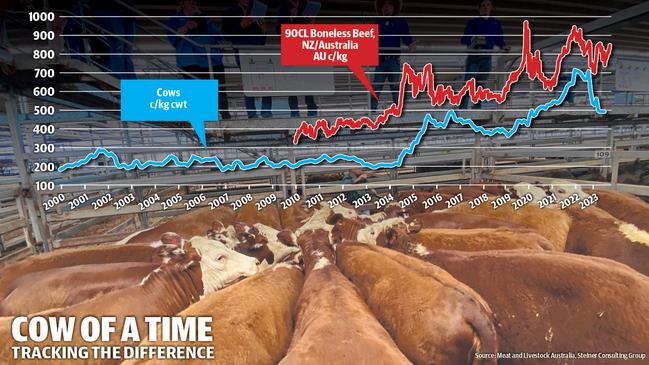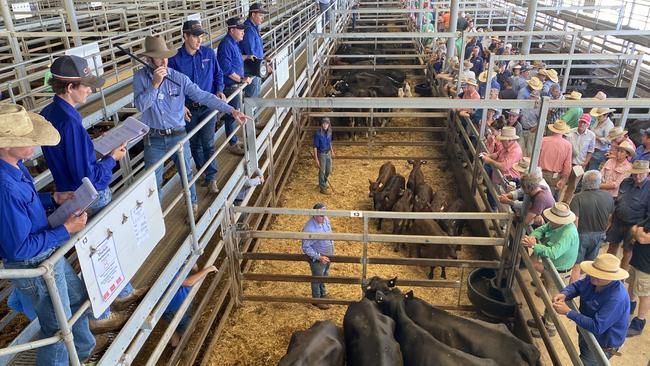Saleyard price for cows has dropped 50c/kg
The balance between what Aussie livestock producers make at market and what it costs to process them is out of whack, and the US is ready to pounce.
If Russian president Putin has been the money maker for grain growers, the El Nino and producer sentiment to bail out of cattle this year has become the equivalent financial windfall for processors.
The Australian cattle market is out of whack – just like the war against Ukraine put the grain market out of step with other world commodities.
In the past month, the average saleyard price for cows has melted down 50c/kg liveweight, or the equivalent of $300 for a 600kg Angus cow.
At the same time, the price for manufacturing beef into the US has lifted by a similar margin, going from about 800c/kg carcass weight delivered port into the United States to now sit close to 850c/kg when converted into Australian currency.
The ‘gap’ between the current cow price in Australia and the ruling price for 90 chemical lean grinding beef into the US has now ballooned out to extraordinary levels.
As the graphic below shows, it has never been this out of balance even during the 2019 drought. The same scenario is evident for steers with US prices now at record premiums to Australian cattle.

According to MLA data, the national saleyard cow price hit a low of 162c/kg liveweight in March 2019. At the time the rate for 90CL beef into the US was 652c/kg, for a difference of about 490c/kg.
Late last week, the saleyard price for cows hit a new low of 146c/kg, while the value of 90CL beef into the US was listed at 849c/kg, for a spread of around 700c/kg.
There is also a gap when the carcass weight values are considered, as shown in this graphic.
To be emotional about it, it means processors are making exceptional profit margins which is why beef shipments to the US have ramped up and the US looks set to reclaim the number one destination for Australian product.
US market analyst Len Steiner, Steiner Consulting, believes Australia will have boosted beef imports to the US by 179 per cent this September compared to the same month last year.
“Australian beef shipments to the US for September are currently projected at 24,000 metric tonnes, which should make the US market once again the top market for Australian beef, well ahead of Japan and above China,” Mr Steiner wrote in his latest industry update.
Now lets be pragmatic about the situation – meaning to look at an issue in a reasonable and logical way.
Processors have been handed the ability to make big margins by a combination of the deteriorating season, the build-up of stock following three generous years, and low producer confidence as they face up to the prospect of a dry El Nino weather pattern.
Cattle supply has become the ruling influence on price over everything else, as shown by the following snapshot of data.
The cattle kill by state for late September is:
66,341 processed in Queensland, up nearly 24,000 or 55 per cent on a year ago.
34,279 processed in NSW, up 12,600 or 58 per cent.
15,609 processed in Victoria, more than double this time last year.
3359 processed in South Australia, up 51 per cent.
Increased supplies in every region have given processors the power to dictate price, particularly as the market has little strength from a restocking or feedlot perspective to put a floor in it.
This is unlikely to change in the short term, with the latest predictions (from those brave enough to make any in these volatile times is the market) values could yet hit lower values – some say November/December and others suggest February/March.
The positive twist from the stark contrast in US beef pricing to Australian cattle prices is it shows the potential our market has for a rally once this current sell off settles down.
To put some perspective around it, the average price difference over time between the US 90CL beef price and the Australian cow price trends at about 250c/kg to 300c/kg.
As detailed above, at present it is more than double this.
To look at it another way, the last time the 90CL price was up around 850c/kg, the average saleyard price for slaughter cows was around 375c/kg liveweight with the best beef cows easily over 400c/kg.

There is an upside for cows, and manufacturing grades like Friesian steers, from today’s low prices and the lift looks incredibly good, particularly as the forecast for US beef prices into 2024 is for even more improvement.
On AuctionsPlus last week, cows and calves were trading from $700 to $1500, averaging around $1100 to $1300. If you can feed them, the value seems tremendous – as it does for nearly all classes of stock.
To recover $1500 from a 600kg female requires the cow market to get back to 250c/kg, which on paper it could easily do at the high US price rate for grinding beef. It is a matter of timing and when the sell-off of cattle across the eastern states to pull supply and demand back into line.




